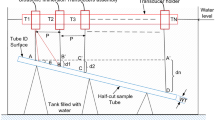Abstract
Tubular-type transmission towers have several advantages, but could be compromised if welding defects from the construction process are not found during deployment. This research derived an equation that illustrates how a change in stress accompanied with mechanical deformation triggered a change in distribution of magnetic flux density. Furthermore, it verified experimentally that a change in distribution of magnetic flux density occurred due to a change in stress at the welding zone. Using this principle, this research proposes a system to measure residual stress occurred in the welding zone of tubular-type transmission tower. The ultrasound examination results were compared and the result showed that ultrasound signals revealed defects in a place where sudden distribution of magnetic flux density was presented. However, when a number of welding defects occurred across the large area, the distribution of magnetic flux density may not change due to the alleviating effect of the stress concentration.
Similar content being viewed by others
References
KEPRI report, Investigation of failures of 154 kV tubulartype transmission tower (2012).
J. U. Park and H. W. Lee, Effects of initial condition of steel plate on welding deformation and residual stress due to welding, J. of Mechanical Science and Technology, 21 (3) (2007) 426–435.
V. Nagarkar, J. Gordon, S. Vasile, P. Gothoskar and F. Hopkins, High resolution X-ray sensor for non destructive evaluation, Nuclear Science Symposium and Medical Imaging Conference Record, 43 (1996) 1559–1563.
Y. Ito, T. Masuda, K. Nagao and K. Matsuoka, Ultrasonic testing system for ERW mill, IAS '97, 2 (1997) 866–872.
W. Yi and I. Yun, The defect detection and non-destructive evaluation in weld zone of austenitic stainless steel 304 using neural network-ultrasonic wave, J. of Mechanical Science and Technology, 12 (6) (1998) 1150–1161.
C. Ni, L. Hua, X. Wang, Z. Wang, X. Qin and Z. Fang, Coupling method of magnetic memory and eddy current nondestructive testing for retired crankshafts, J. of Mechanical Science and Technology, 30 (7) (2016) 3097–3104.
V. Uchanin and V. Najda, The development of eddy current technique for WWER steam generators inspection, InTech. (2011) 145–164.
M. Le, J. Kim, S. Kim, D. Wang, Y. H. Hwang and J. Lee, Nondestructive evaluation algorithm of fatigue cracks and far-side corrosion around a rivet fastener in multi-layered structures, J. of Mechanical Science and Technology, 30 (9) (2016) 4205–4215.
J. Kim, J. Lee, M. Le, J. Jun, C. Cho and K. Shin, Improvement of crack inspection possibility using the gradient directional magnetization and linearly integrated Hall sensors, J. of Mechanical Science and Technology, 26 (11) (2012) 74–81.
P. E. Mix, Magnetic flux leakage theory, In introduction to nondestructive testing: A training guide, Wiley-Interscience (2005) 73–78.
A. Dubov and S. Kolokolnikov, Assessment of the material state of oil and gas pipelines based on the metal magnetic memory method, Welding in the World, 56 (3) (2012) 11–19.
M. Roskosz, A. Rusin and J. Kotowicz, The metal magnetic memory method in the diagnostics of power machinery componen, Journal of Achievements in Materials and Manufacturing Engineering, 43 (1) (2010) 362–370.
Author information
Authors and Affiliations
Corresponding author
Additional information
Recommended by Associate Editor Sang-Hee Yoon
Jungmin Kim was born in Korea in 1979. He received the master and Ph.D. degrees in control and instrumentation engineering from Chosun University, Gwangju, Korea, in 2010 and 2013, respectively. He is currently working as Research Professor at Chosun University, Korea. His research interests are Nondestructive testing and Magnetic camera.
Minhhuy Le was born in Vietnam in 1986. He received the bachelor degree in mechatronics from Ha Noi University of Technology, Hanoi, Viet Nam, in 2009. He received the master and Ph.D. degrees in control and instrumentation engineering from Chosun University, Gwangju, Korea, in 2011 and 2014, respectively. He is currently working as Post-doc Researcher at Chosun University, Korea. His research interests are Nondestructive testing & Evaluation, specialized in magnetic camera and ultrasonic testing.
Juhyeon Park was born in Gwangju, Korea in 1990. He received the bachelor degree in control and instrumentation robotics engineering Gwangju, Korea, in 2014. He received the master degree in control and instrumentation engineering from Chosun University, Gwangju, Korea, in 2016. He is a Ph.D. candidate at the Chosun University, Korea. His research interests are Nondestructive testing & Evaluation, specialized in magnetic camera.
Heejoon Seo was born in Hampyeong, Korea in 1992. He received the bachelor degree in control and instrumentation robotics engineering from Chosun University, Gwangju, Korea, in 2017. He is currently working as masters and doctorate integration course, Chosun University, Korea. His research interests are Nondestructive testing & Evaluation, specialized in magnetic camera and ultrasonic testing.
Gyejo Jung received the bachelor degree in mechanical engineering from Busan University, Busan, Korea, in 1985. Also he received the master degree in mechatronics engineering from Chungnam University, Daejeon, Korea, in 1999. Since 1995, he has been an NDT engineer for thermal power plants and nuclear power plants. He has ASNT Level III of UT, ET and RT, respectively. His research interests are in application of metal magnetic memory method with fluxgate sensors and development of inspection device for power facilities.
Jinyi Lee received the bachelor degree in mechanical design from Chonbuk University, Jeonju, Korea, in 1992. Also he received the master and Ph.D. degrees in mechanical and aeronautics & space engineering from Tohoku University, Sendai, Japan, in 1995 and 1998, respectively. Since 2003, he has been an Associate Professor of Chosun university. He is the author or coauthor of many patents and scientific papers. His research interests are in application of magneto-optical film, laser and CCD line scan sensor and development of magnetic camera.
Rights and permissions
About this article
Cite this article
Kim, J., Le, M., Park, J. et al. Measurement of residual stress using linearly integrated GMR sensor arrays. J Mech Sci Technol 32, 623–630 (2018). https://doi.org/10.1007/s12206-018-0109-1
Received:
Revised:
Accepted:
Published:
Issue Date:
DOI: https://doi.org/10.1007/s12206-018-0109-1




